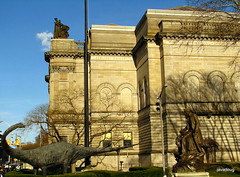I've been waiting for many years to hear this Schubert symphony performed by the Pittsburgh Symphony Orchestra, and tonight I deliciously had my chance, especially the very end with that marvelous sawing of bows in such a deep and uniform aggregate, producing such rich an deep sound; four saws, followed by the horns in a higher key, then repeated again -- simply amazing!
Gianandrea Noseda was the perfect conductor, the centerpiece --
The hop in his step, and who didn't notice,
the animation, the concentration, the total dedication,
Noseda conducting the great Schubert symphony,
was the center of the show, poised at his station.
The animated conductor, the painter of melody,
the artisan, the craftsman, the illustrator of harmony,
with swagger and great vigor, dancing his rhythm,
dipping, as the lead, where the dance of the music,
is the heart of the show.
Majesty and romanticism, in a great C major,
the orchestra followed as if part of the wager,
right arm with baton, left circled around
as if to encompass, the players to surround.
The first movement would commence
fast tempo setting pace,
soft and subtle, then building a steady flow,
marching with rhythm, and off to the race.
Proceed to the oboe, a slow movement Andante
ever so slow, and yet somewhat jaunty.
Next Scherzo of three, is ever so free,
a joke on the inside, I happen to see.
Finale to hear, Allegro vivace, Allegro vivace,
so regular and nice they sure named it twice
Trombones with the horns, vivid and catchy
Deep sawing of bows, deep and concise.
Eleven years after Schuber's death this majestic C-Major symphony was first played, and legend has it that during the first movement, one musician mused: "I have not yet heard a tune." I've heard that there aren't many memorable 'tunes' in Beethoven's works either. But isn't a 'tune' nothing more than a melody? Yet I also read that there is indeed much melody present in this symphony by Schubert. And if melody is the tune, and there is indeed melody in this symphony, then why say there is no tune? Perhaps the complaint is the memorability of the tune. Is it memorable, repeated, rephrased, perhaps overly so? Perhaps the whole of Schubert's harmony and melody combined, in an amalgamation of building dramatic parcels of phrases, in a very rhythmic and marching style, repeated in various different ways and forms, with creative development, all lend my ears and mind to perceive a fantastic statement of beauty. When one ponders "Whatever happened to beauty?" -- one need not look farther than Schubert's Symphony number 9, the Great C-Major symphony. If I am to believe in legend, I'll believe this one: 'that having heard its first performance, Schumann is reported to have said he thought it the greatest instrumental work since the death of Beethoven'. I quite agree.




